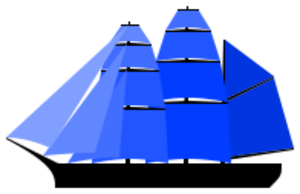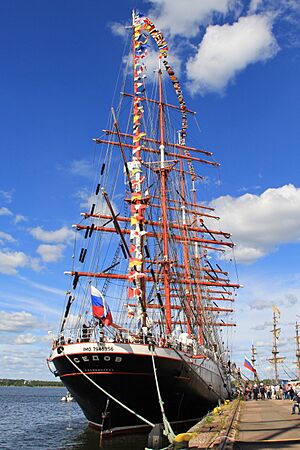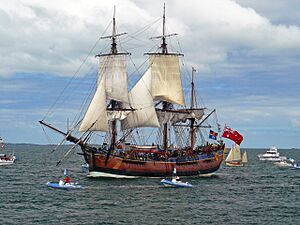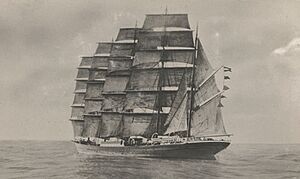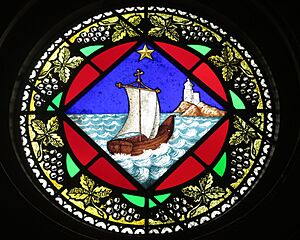Barque facts for kids
A barque (pronounced "bark") is a type of sailing vessel with three or more masts. On a barque, the front masts (like the foremast and mainmast) have square sails. But the very back mast (called the mizzen mast on a three-masted barque) has fore-and-aft sails. Sometimes, the mizzen mast might have a square sail above its fore-and-aft sails.
Contents
What's in a Name?
The word "barque" came into English from the French word, which itself came from the Latin word barca. This Latin word traveled through other languages like Occitan, Catalan, Spanish, or Italian.
In Latin, Spanish, and Italian, barca usually means a small boat, not a large ship. But because of French influence in England, both "barge" and "barque" became English words. Over time, their meanings changed.
By the 19th century, a "barge" meant a small boat used near coasts or on rivers. It could also be a fast rowing boat used by warships for their commanders. A "bark" then became a sailing ship with a special type of sail setup. In Britain, by the mid-1800s, the spelling "barque" became common.
Today, to avoid confusion, "barque" refers to the ship. "Bark" refers to either a sound (like a dog's bark) or the outer layer of a tree.
In the 1700s, the Royal Navy (Britain's navy) used the word "bark" for ships that didn't fit into their usual categories. For example, when the British navy bought a coal ship for James Cook's famous journey, they called her HM Bark Endeavour. This was to tell her apart from another ship named Endeavour that was already in service.
A dictionary from that time, Dictionary of the Marine by William Falconer, said that "bark" was a general name for small ships. But sailors used it especially for ships with three masts that didn't have a mizzen topsail. Sailors from the coal trade used it for wide-sterned ships that didn't have fancy decorations on their front or back.
What Makes a Barque Rig?
By the late 1700s, "barque" (or "bark" in the US) specifically meant a ship with a certain sail plan. This plan includes three (or more) masts. The back-most mast has fore-and-aft sails, which run along the length of the ship. All the other masts have square sails, which run across the ship.
Barques were very popular in the mid-1800s, during the "golden age of sail." They could travel almost as fast as full-rigged ships but needed smaller crews. This meant they were cheaper to operate.
One big advantage of barques was that they needed fewer sailors than full-rigged ships or brigs. This is because they used fewer of the large, labor-intensive square sails. Also, the rigging itself was less expensive. Full-rigged ships, with more square sails, were often kept for training vessels because they needed bigger crews, which meant more sailors could be trained.
Barques also had other benefits. When sailing with the wind, a barque could go faster than a schooner or barkentine. They were also easier to handle and better at sailing against the wind than a full-rigged ship. While a full-rigged ship was best for sailing directly with the wind, and fore-and-aft rigged ships were best for sailing into the wind, barques were a good mix of both.
Most large ocean-going windjammers were four-masted barques. This was because of their good balance of speed and crew size. The main mast was usually the tallest. A four-masted barque could be sailed with a surprisingly small crew, sometimes as few as 10 people. The usual crew was about 30, and nearly half of them could be apprentices learning to sail.
Today, many school ships, which are used to train new sailors, are barques.
There are several famous barques that are still around today:
- The Pommern is a well-preserved barque in Mariehamn, Åland. It's the only windjammer still in its original condition.
- The wooden barque Sigyn, built in 1887, is now a museum ship in Turku.
- The wooden whaling barque Charles W. Morgan, launched in 1841, is a museum ship at Mystic Seaport in Connecticut. It still sails sometimes!
- The United States Coast Guard has an active barque called the USCGC Eagle. It was built in Germany in 1936 and is used to train cadets at the United States Coast Guard Academy.
- The Sydney Heritage Fleet restored an iron-hulled three-masted barque, the James Craig, which sails regularly.
- The Star of India, built in 1863, was originally a full-rigged ship but was changed into a barque in 1901. It's the oldest active sailing vessel in the world.
The French composer Maurice Ravel was inspired by this type of ship to write his famous piano piece, Une Barque sur l'ocean (A Barque on the Ocean), in 1905.
The Statsraad Lehmkuhl is another active barque. It's used as a school ship for training future sailors and for the Norwegian Navy. It also takes volunteers interested in sailing. In 2021, it sailed around the Norwegian coast and across the North Sea. It is also planning its first full trip around the world, which will take about 19 months. It has scientific equipment to collect environmental data.
Barques in Ancient Egypt
In Ancient Egypt, barques were a type of boat used from the earliest times. They are shown in many ancient drawings, paintings, and carvings. Egyptians believed that transportation to the afterlife happened by barques. Images of these boats are found in many religious murals and carvings in temples and tombs.
The most important Egyptian barque carried the dead pharaoh to become a god. Great care was taken to make beautiful barques for this journey. Models of these boats, from tiny to very large, have been found in tombs. Wealthy and royal people also had barques for their final journey. The boats shown in Egyptian art stayed very similar for thousands of years.
Barques were important religious objects. Since the gods were thought to travel in this way in the sky, the Milky Way was seen as a great waterway, just as important as the Nile River on Earth. Statues of the gods traveled by boat on water, and special ritual boats were carried by priests during festival ceremonies. Temples had special barque shrines, sometimes more than one, where the sacred barques rested when they were not being used in a procession. Priests would watch over and care for these boats.
The Barque of St. Peter
The Barque of St. Peter is a special name for the Roman Catholic Church. This term refers to Peter, who was the first Pope and a fisherman before he became a follower of Jesus. People often say that the Pope is "steering" the Barque of St. Peter, meaning he is guiding the Church.
Images for kids
-
Three-masted barque (US Revenue Cutter Salmon P. Chase, 1878–1907)
-
A 1993 replica of HM Bark Endeavour
See also
- Barquentine or barkentine (three masts, fore mast square-rigged)
- Brigantine (two masts, fore mast square-rigged)
- Jackass-barque (three masts, fore mast and upper part of mizzen mast square-rigged)
- Schooner
- Windjammer
- List of large sailing vessels



